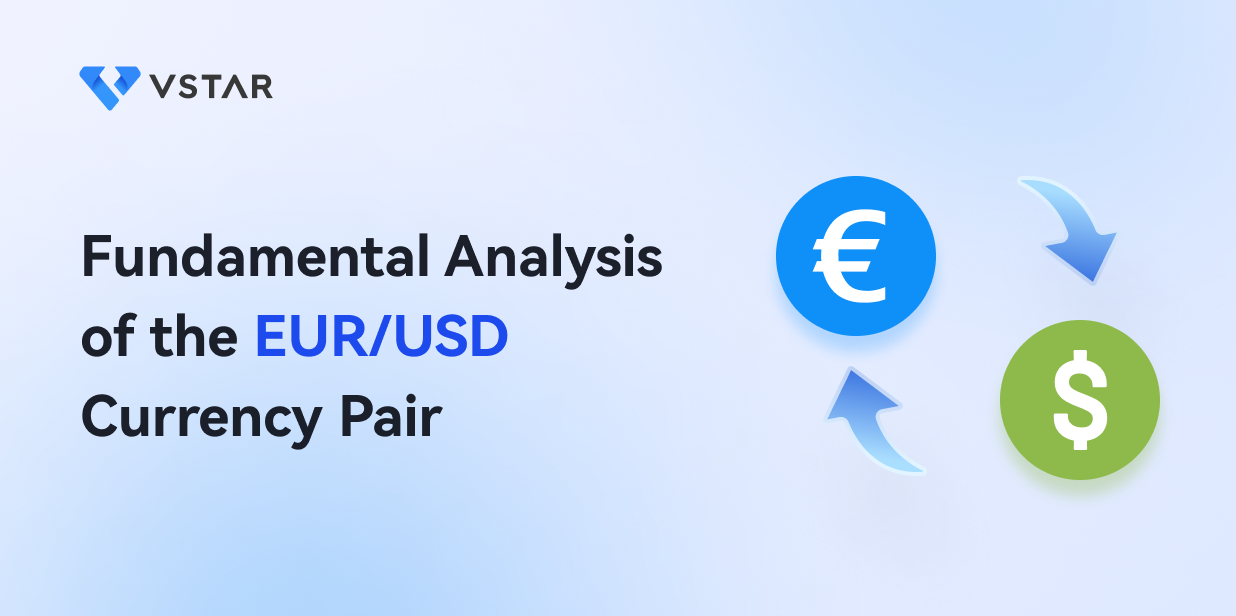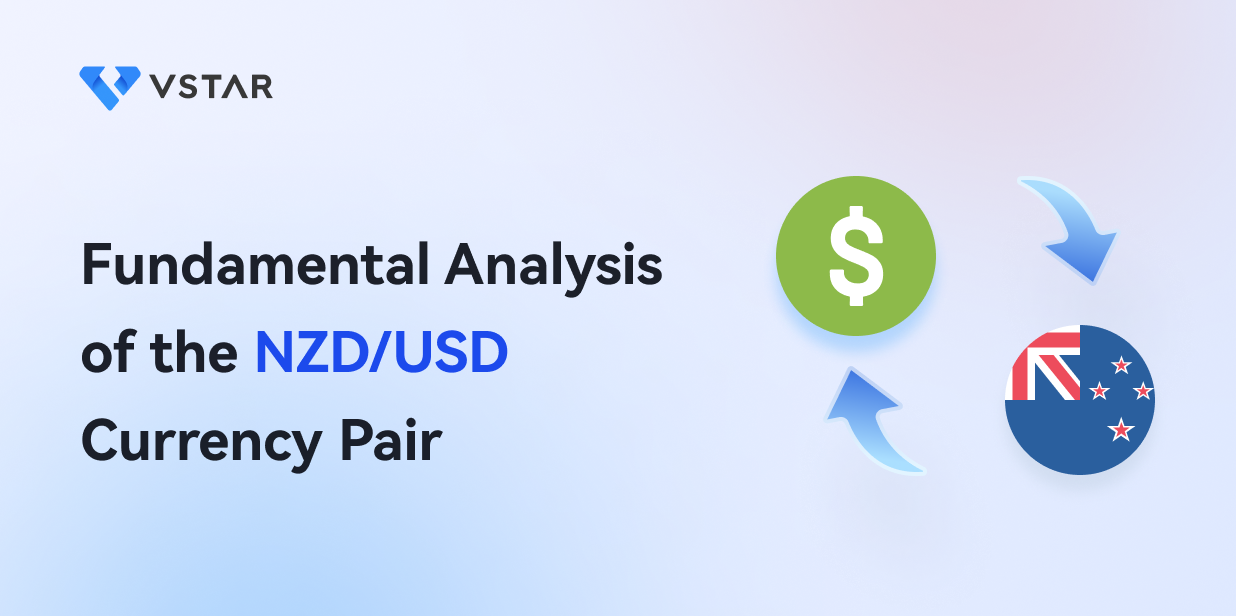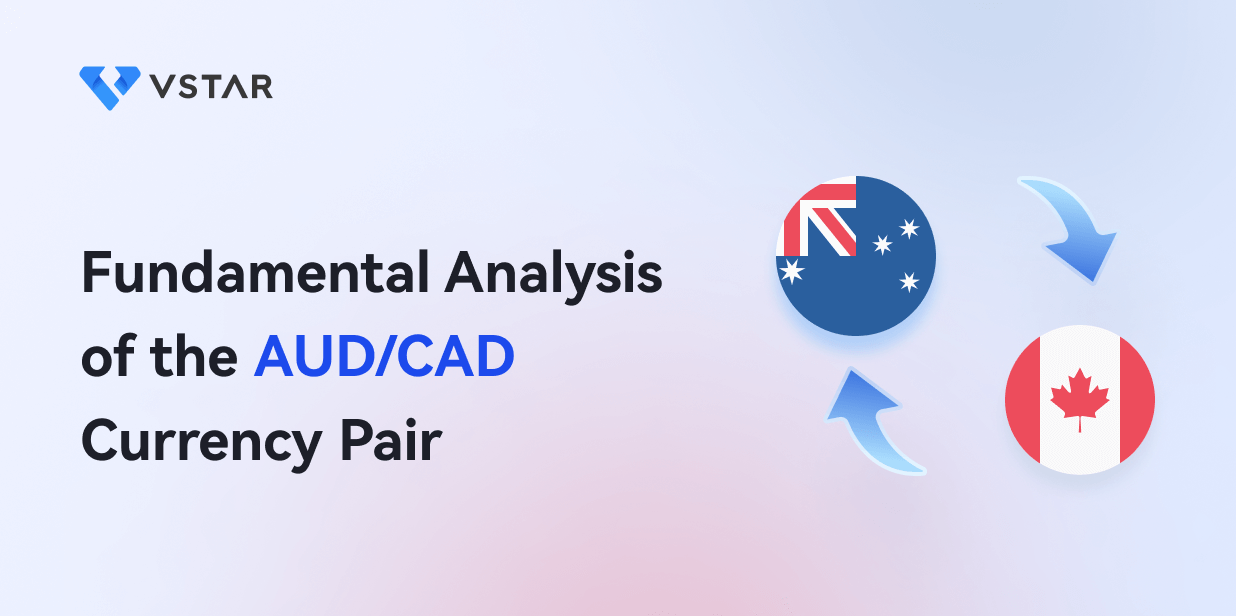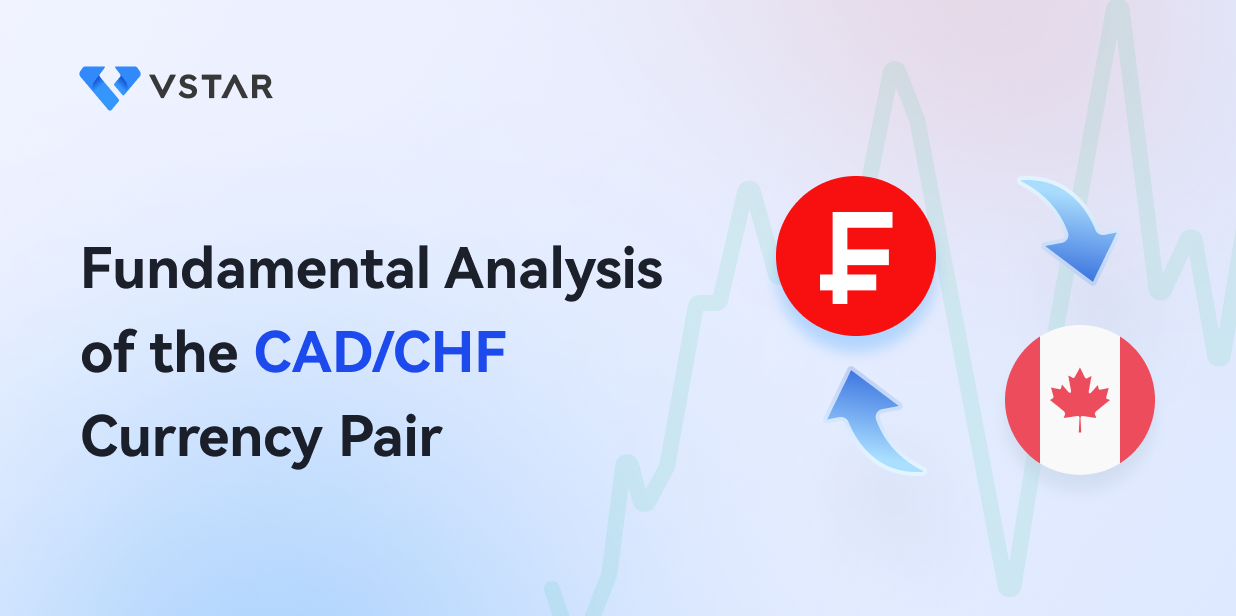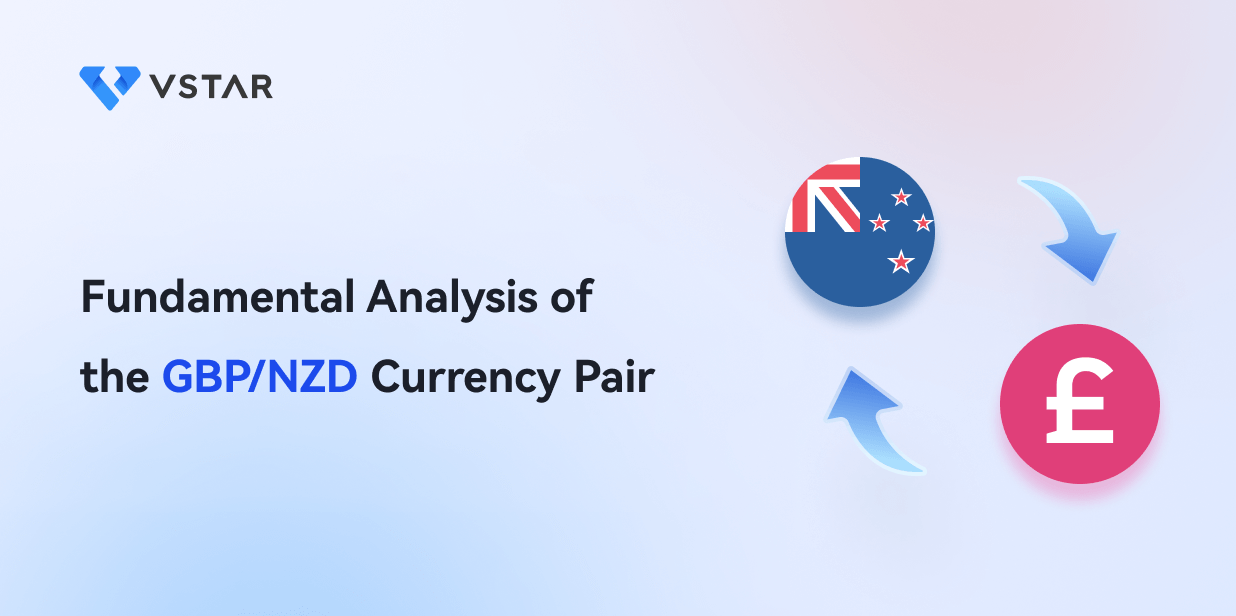Introduction
The exchange rate between the US dollar, the official currency of the United States, and the Euro, the official currency of the Eurozone, is represented by one of the most popular currency pairs in the world, known as EUR/USD.
Numerous variables, including economic indicators like GDP growth rates, inflation, interest rates, and political developments in the European Union and the United States, significantly impact the value of this currency pair.
The value of the US dollar typically rises when the US economy is doing well, which might result in a decline in the value of the Euro. Similarly, when the Eurozone’s economy is strong, the value of the Euro may rise, causing the value of the US dollar to fall.
Importance of Fundamental Analysis
Fundamental research is a crucial tool for traders to assess the long-term prospects of the EUR/USD currency pair. This kind of analysis entails looking at the underlying economic, financial, and political variables that influence the Euro/US dollar exchange rate.
Among the most important fundamental aspects that traders keep an eye on are:
Economic indicators: To assess the strength of the economies in the Eurozone and the United States, traders use data such as GDP growth, inflation rates, employment statistics, and consumer mood. While bad economic data might weaken the currency, positive economic data can strengthen it.
Central bank policies: The US Federal Reserve (Fed) and the European Central Bank (ECB) greatly impact the EUR/USD exchange rate. The interest rate choices, monetary policy announcements, and other policy measures that may affect the currency pair are closely watched by traders.
Political developments: The EUR/USD exchange rate may be impacted by shifts in political power, trade agreements, and geopolitical conflicts.
Explanation of the Euro and the US dollar
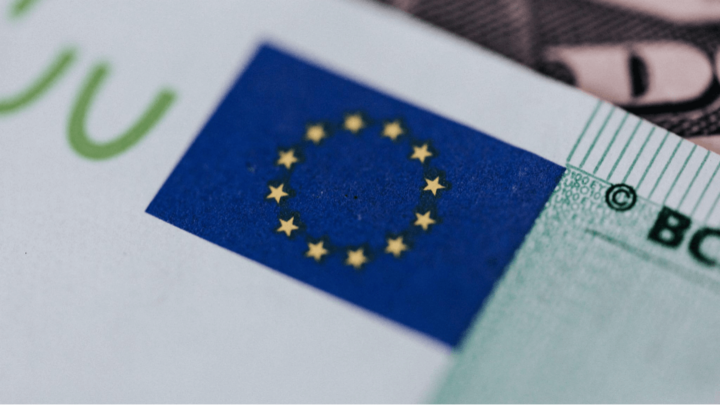
The official currency of the Eurozone, which includes 19 of the 27 members of the European Union, is the Euro (€). The Euro was first launched in 1999, and by 2002, it had become a legal tender. After the US dollar, the Euro is the second most traded and the second most widely held reserve currency in the world.
The official unit of exchange for the United States and its territories is the US dollar ($). It is the principal reserve currency for the entire world and the currency that is utilized in international transactions the most. The Federal Reserve System, the country's central banking system, is in charge of issuing US dollars.
The Euro and the US dollar are considered major currencies and are widely traded in the foreign exchange market. The value of these currencies is determined by a range of factors, including economic performance, political developments, interest rates, and market sentiment. The exchange rate between the Euro and the US dollar is the most widely traded currency pair globally and is an important benchmark for other currency pairs and financial instruments.
Macroeconomic Overview – Eurozone
To trade the Euro against the dollar, or anything else for that matter, you need to understand some of the major economic indicators that fundamental analysis pays close attention to.
Gross Domestic Product (GDP):
The GDP of the Eurozone is a measure of the total value of all goods and services produced in the 19 member states. The Eurozone GDP has experienced positive and negative growth in recent years. In 2019, the Eurozone GDP was €13.2 trillion, representing a growth rate of 1.2%. However, the COVID-19 pandemic significantly impacted the Eurozone's economy, leading to a contraction of 6.6% in GDP in 2020.
The Eurozone's GDP is affected by several factors, including consumer spending, business investment, government spending, and exports. When these factors increase, the GDP tends to grow, and when they decrease, the GDP tends to contract.
Unemployment Rate:
The Eurozone's unemployment rate is another crucial economic indicator. It measures the percentage of the labor force that is unemployed but actively seeking employment. In general, a high unemployment rate is a sign of economic weakness, while a low unemployment rate suggests a robust economy.
Before the COVID-19 pandemic, the Eurozone's unemployment rate had been declining steadily from its peak of 12.1% in 2013 to 7.4% in February 2020. However, the pandemic significantly impacted the labor market, leading to a sharp increase in unemployment. The Eurozone's unemployment rate peaked at 8.3% in July 2020 and has since declined slightly to 7.9% in February 2021.

Inflation Rates:
Inflation measures the rate at which the general price level of goods and services in an economy is increasing. The Eurozone's inflation rate is measured by the Harmonized Index of Consumer Prices (HICP), which considers changes in the price of goods and services purchased by households.
A moderate inflation rate is generally seen as a sign of a healthy economy, as it indicates that consumer demand is increasing without causing runaway price increases. However, if inflation rises too quickly, it can cause instability in the economy and reduce consumer purchasing power.
In recent years, the Eurozone has experienced low inflation rates, which has prompted the European Central Bank (ECB) to implement policies to stimulate inflation. In 2020, the inflation rate in the Eurozone was 0.3%, well below the ECB's target of close to 2%.
Business and Consumer Confidence:
Business and consumer confidence indicators reflect the sentiment of companies and individuals regarding the current and future economic environment. The Eurozone's business and consumer confidence indicators are measured by the European Commission's Economic Sentiment Indicator (ESI) and the Consumer Confidence Indicator (CCI).
A high level of business confidence indicates that companies are optimistic about the future and are likely to invest in new projects and hire more workers. Similarly, a high level of consumer confidence suggests that individuals are more willing to spend money, which can drive economic growth.
Monetary Policy
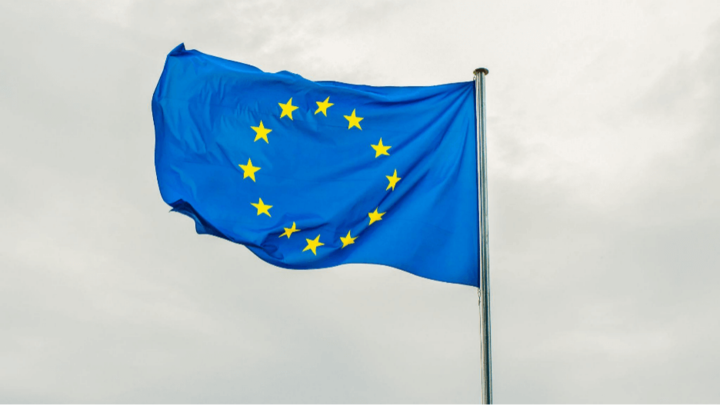
European Central Bank’s Monetary Policy
The ECB's primary objective is to maintain price stability, defined as an inflation rate of below, but close to, 2% over the medium term. To achieve this objective, the ECB uses various tools, including setting interest rates, conducting open market operations, and providing liquidity to the banking system.
The ECB's monetary policy decisions are made by the Governing Council, which consists of six members of the Executive Board and the governors of the national central banks of the Eurozone countries. The Governing Council meets regularly to assess economic conditions and make decisions about monetary policy.
Interest Rate Expectations
Interest rates are a key tool in the ECB's monetary policy toolkit. The ECB sets the interest rates at which banks can borrow money from the ECB, affecting the interest rates that banks charge their customers.
When the ECB lowers interest rates, it makes it cheaper for banks and customers to borrow money, which can stimulate economic growth. Conversely, when the ECB raises interest rates, it makes borrowing more expensive, which can help to control inflation but may also slow down economic growth.
Political Climate

The political climate in the European Union has a big part to play in the performance of the Euro. The political climate in monetary, fiscal and trade policies is a crucial part of the process of fundamental analysis.
Monetary and Fiscal Policies:
The European Central Bank (ECB) implements monetary policy in the Eurozone. The ECB aims to maintain price stability and support economic growth by controlling interest rates, providing liquidity to the banking system, and conducting open market operations. Fiscal policy in the EU is the responsibility of individual member states, but there are rules governing budget deficits and debt levels to ensure economic stability.
Trade Policies:
The EU has a significant role in global trade as the world's largest trading bloc. The EU's trade policy is based on promoting open and fair trade while protecting its citizens and industries from unfair practices. The EU negotiates trade agreements with countries and regions around the world and is currently negotiating several agreements, including with the UK, the US, and the Mercosur countries.
The EU also imposes tariffs and other trade measures to protect its industries and citizens. The EU has been involved in several trade disputes in recent years, including with the US over steel and aluminum tariffs and with China over intellectual property rights.
Macroeconomic Overview – United States

To properly analyze the US dollar, you will need to have a grasp on some of the most important economic indicators in the United States.
Gross Domestic Product (GDP)
GDP is widely regarded as the primary indicator of macroeconomic performance. GDP measures the total value of goods and services produced within a country's borders in a given period. Changes in the GDP, often measured as real growth in GDP, indicate the overall health of the economy. A decline in GDP indicates a contraction in the economy, while an increase indicates growth. In the United States, GDP increased by 2.1% in 2022, after increasing by 5.9% in 2021.
Unemployment Rate
The unemployment rate refers to the percentage of the labor force that is not currently employed but is actively seeking employment. The unemployment rate is a measure of the health of the labor market and the economy. A low unemployment rate indicates a strong labor market and overall economic health, while a high unemployment rate indicates a weak labor market and economic downturn. In the United States, the unemployment rate in March 2023 remained unchanged at 3.5%.
Inflation Rate
The US inflation rate is a key economic indicator that measures the rate of increase in consumer prices over time. As of December 2022, the year-over-year inflation rate was 6.5%. Inflation has been a growing concern in the US economy, causing consumers to take action, such as dipping into their savings or reducing the amount they're setting aside. The inflation rate is expected to remain well above the Federal Reserve's 2% target through the end of 2023.
Business and Consumer Confidence

Business and consumer confidence are also important economic indicators that can provide insight into the economy’s overall health. In the US, consumer confidence has been impacted by rising inflation and interest rate hikes, with the expectations index reaching its lowest level in nearly a decade in June 2022. However, in September 2022, the Conference Board reported an improvement in confidence which may bode well for consumer spending in the final months of 2022. On the other hand, business confidence remains strong as companies continue to report strong demand for workers despite slowing job growth.
Since consumer spending is so important to the US economy, the Consumer Confidence Index is one of the most closely watched economic indicators. The index is based on a survey of consumers' attitudes toward current and future economic conditions and is used to gauge consumer spending activity. The Conference Board expects consumer inflation rates to remain high through the end of 2023. Overall, the US economy is in a strange place as inflation has become a growing concern for consumers, while business and consumer confidence have remained resilient despite headwinds to growth.
Monetary Policy
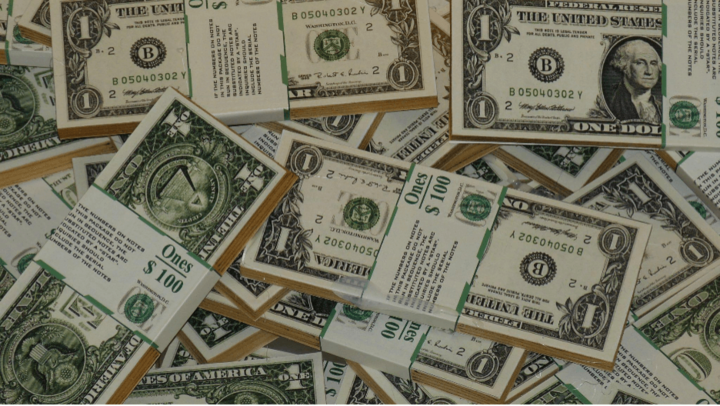
You should also know the United States monetary policy to trade the US dollar effectively.
Federal Reserve’s Monetary Policy
The Federal Reserve's monetary policy and interest rate expectations are important indicators for fundamental analysis. The Federal Reserve is responsible for setting monetary policy in the United States and promoting maximum employment, stable prices, and moderate long-term interest rates. The Federal Reserve's interest rates and monetary policy decisions can significantly affect the economy and financial markets.
Interest Rate Expectations
Interest rate expectations are key to the Federal Reserve's monetary policy. The Federal Reserve raises or lowers interest rates to influence the economy, typically by adjusting the federal funds rate, which is the interest rate banks charge each other for overnight lending. Investors closely monitor the Federal Reserve's interest rate decisions and projections to anticipate potential changes in the economy and financial markets.
The Federal Reserve's interest rate expectations are typically reflected in the Federal Open Market Committee (FOMC) projections, the body within the Federal Reserve responsible for setting monetary policy. The FOMC releases projections on the economy, interest rates, and unemployment rates, among other factors. The FOMC has raised interest rates several times in recent years, with the target range for the federal funds rate currently standing at 4.75%-5%.
Political Climate
The political climate of the United States government is worth paying attention to, as the decisions made by the government can greatly impact the value of the greenback.
Economic policies of the US government
The US Government's economic policies can significantly impact the US dollar and are closely watched by analysts and investors. The Treasury is responsible for analyzing and reporting on current and prospective economic developments in the US and world economies and assists in the determination of appropriate economic policies.
The economic policies of the US are influenced by a wide variety of factors, including laws, lobbyists, the global economic climate, and the will of the people. These policies can be used to influence the three principal methods of establishing control: the allocative function, the stabilization function, and the distributive function.
US and international trade policies

US government trade policy can indirectly impact the economy and serve as an economic indicator. The United States trade policy is developed through a cooperative process involving numerous federal agencies, Congress, and the executive branch. The U.S. Congress sets trade negotiating objectives, enacts trade laws, programs, and agreements, and oversees the executive. The current administration's trade policy aims to promote inclusive economic growth that reflects American values.
Changes in US trade policy can affect industries and economic sectors, particularly those that are import- or export-dependent. For example, changes in tariffs or trade agreements can impact the competitiveness of U.S. industries. Changes in trade policy can also indirectly impact the economy through the exchange rate, as trade policy changes can influence the demand for US currency and affect its value relative to other currencies.
Analysis of the EUR/USD Currency Pair
Correlation between the EU and US economies
The United States and the European Union are the world's largest economic powers. The EU and the US have a strong economic relationship, with around $1.2 trillion in bilateral trade. The economies of the EU member states are highly interdependent, with Germany having the largest economy in Europe, followed by France. There have been fluctuations in the relative strengths of the US and EU economies over time. While arguments can be made for the EU, there is no way of slicing the data to make the continent's biggest economies richer than the US, and even in terms of GDP per capita, the US generally comes out ahead of European countries. Recently, inflation has been a concern for the US and the EU, with rising costs affecting both regions. The EU and the US remain important economic partners.
Impact of GDP growth, inflation rates, and interest rates on the currency pair
The EUR/USD pair can be impacted by several economic factors, including GDP growth, inflation rates, and interest rates. GDP growth represents an economy’s size and growth rate, and a higher GDP growth rate may increase demand for a country's currency, leading to the appreciation of that currency. Similarly, higher interest rates may increase demand for a currency, as investors may seek higher returns on their investments. Conversely, higher inflation rates may decrease demand for a currency as the purchasing power of that currency is diminished. It is important to note that these economic factors can also be impacted by external and internal factors, and the relationship between them can be complex and ever-changing.
Factor Supporting a Bullish or Bearish Stance
There are several potential reasons to form a bullish or bearish stance in this pair, including:
Impact of the European Central Bank’s monetary policy on the pair
Monetary policy in the Eurozone is decided by the European Central Bank (ECB), which may have an effect on the EUR/USD pair. The monetary policy strategy of the ECB is created to give decision-makers an analytical framework for converting economic events into policy decisions and for interacting with the general public. The ECB has been concentrating on normalizing its monetary policy in recent years after years of stimulus measures in response to the epidemic and the global financial crisis.
Interest rates are one of the primary instruments the ECB use to carry out monetary policy. The ECB can affect how much it costs for people and businesses to borrow money by changing interest rates, which can have an effect on inflation and economic growth.
Impact of the Federal Reserve’s monetary policy on the pair
It is important to note that the Federal Reserve's monetary policy decisions can affect the value of the U.S. dollar, which in turn can impact the exchange rate between the USD and other currencies, including the EUR.
The Federal Reserve's monetary policy decisions, such as changes in interest rates, can affect the demand for U.S. dollars and influence the direction of the currency's value. For example, higher interest rates can make the U.S. dollar more attractive to investors, potentially increasing its value relative to other currencies, while lower interest rates can have the opposite effect. Additionally, the Federal Reserve's actions can influence market sentiment and expectations, impacting the value of the U.S. dollar and the EUR/USD pair.
Impact of the EU and US trade policies on the EUR/USD pair

The EUR/USD pair is impacted by various factors, including trade policies between the United States and the European Union. The main goal of the EU's trade policy is to increase trading opportunities for European companies by removing trade barriers such as tariffs and quotas and guaranteeing fair competition. More than 36 million jobs in the EU depend on exports outside the European Union.
Changes in trade policies can affect the value of each currency in the EUR/USD pair. For example, changes in tariffs and trade barriers can cause the value of the Euro to rise or fall against the US dollar. Furthermore, political events that influence trade policies can also impact the exchange rate. The exchange rate for the Euro to Dollar is impacted by many economic factors and political events on both sides of the Atlantic.
Potential Risks to the Currency Pair
If you are going to trade a financial market, you need to understand the potential risks to that market. This is going to be the same in the EUR/USD pair.

Suddenly changes in global economic growth
The EUR/USD pair may be significantly impacted by global economic development. Demand for the euro may drop, and US dollar demand may rise due to abrupt changes in economic growth, particularly slowdowns or recessions. This might lead to a decline in the euro's value relative to the dollar, impacting trade and investment between the EU and the US.
Rising interest rates, inflation, and geopolitical unrest are other factors that could affect the EUR/USD exchange. Prices and usage of energy may also affect the couple.
Unpredicted changes in EU or US monetary policies
One thing that can cause a lot of movement in a currency pair is unexpected announcements. The monetary policy of a central bank is one of the biggest influences on a currency. If the market isn’t expecting a central bank to raise rates, as an example, this could send ripples throughout the markets, and the EUR/USD pair would be the same.
Geopolitical Risks

The EUR/USD pair is susceptible to severe effects from geopolitical uncertainties. These dangers could include conflict, political unrest, and economic penalties imposed on a nation. Geopolitical issues can significantly affect the currency market because they may prompt investors to flee for cover, increasing demand for safe-haven currencies like the US dollar. The US dollar may rise against other currencies like the euro due to this increased demand, which would result in a decline in the EUR/USD pair. The market might also respond to the anticipated geopolitical threats in the future, which might affect the EUR/USD pair. Geopolitical risks, such as those brought on by the ongoing conflict between Russia and Ukraine, could, for instance, affect the EUR/USD pair in the future.
Trading Strategies for EUR/USD
Technical Analysis
Technical analysis is a technique for assessing securities that involve looking at market data such as historical prices and volume. Charts and other tools are used by technical analysts to spot patterns and trends that can be used to forecast future price movements. They hold that market activity alone serves as the best gauge of a security's worth and that by analyzing past price and volume data, one may predict future price alterations. Stock, bond, commodity, and currency trading all frequently use technical analysis.
Identifying trends and patterns
Technical analysis mainly focuses on spotting trends and patterns on currency charts. The general direction in which prices are moving is known as a trend, and it can be either an uptrend or a downtrend (with prices rising over time). Contrarily, patterns are predetermined formations that can be seen on a chart, including triangles, head and shoulders, and flags.
Traders frequently employ trendlines, lines drawn on the chart that connect two or more price points, to spot trends. A downtrend line is produced by joining a string of lower highs, whereas an uptrend line is formed by joining a string of higher lows. When a trendline is broken, the trend may change.
Traders search for particular formations on the chart, such as a head and shoulders pattern with three peaks, the center peak being the tallest, to identify patterns. This pattern is frequently interpreted as a precursor to a pending trend reversal. Another illustration is a flag pattern, which develops after a rapid price increase and is frequently regarded as a continuation pattern.
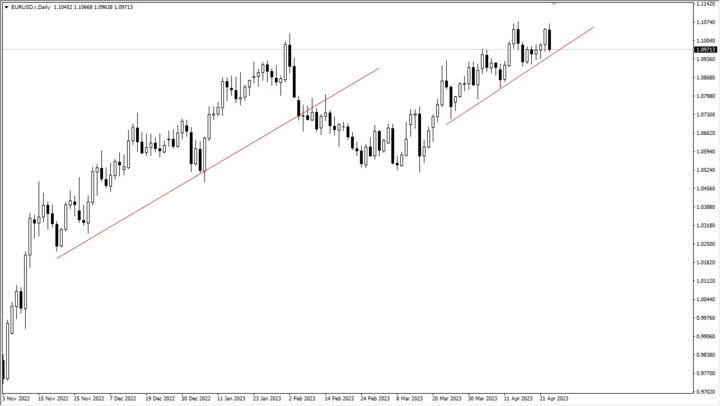
Trendlines on the EUR/USD chart.
Use of indicators such as moving averages and Fibonacci retracements
Technical analysis strategies are frequently employed in trading EUR/USD, one of the most actively traded currency pairs on the forex market, including moving averages and Fibonacci retracements.
Moving averages are trend-following indicators determined by averaging a currency pair's price over a predetermined period. Traders often use moving averages to identify the direction of the trend and potential areas of support and resistance. For instance, the EUR/USD price may signal an uptrend if it is above its 50-day moving average and a downtrend if it is below its 200-day moving average.
Based on the Fibonacci sequence, Fibonacci retracements are levels used to pinpoint probable regions of support and resistance. Traders spot a significant price move on the chart and look for potential retracement levels using the Fibonacci levels of 23.6%, 38.2%, 50%, 61.8%, and 100%. These levels are frequently utilized to pinpoint probable trading entry and exit opportunities.
Moving averages and Fibonacci retracements can be combined in EUR/USD trading to pinpoint possible support and resistance points and validate trends. For instance, traders can check to see whether the price of EUR/USD is crossing a moving average as it approaches a significant Fibonacci retracement level to validate a potential area of support or resistance.
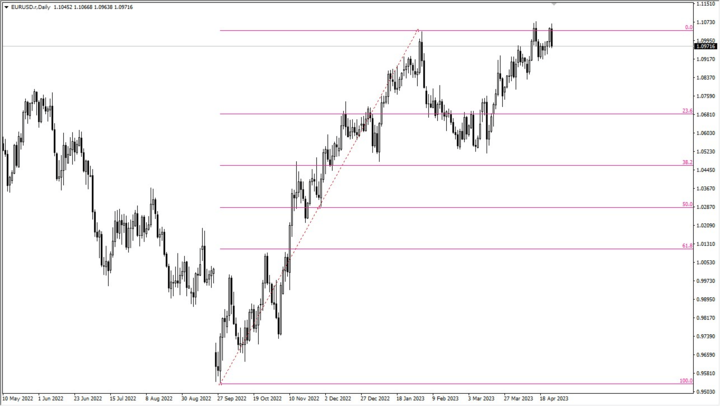
Risk Management
Risk management is crucial to long-term success in any market, as protecting your trading capital is the first job of a professional trader.
Setting Stop-Loss and Take-Profit Levels
Before you ever put money to work in the market, you must decide where you recognize that your analysis is wrong and set a stop-loss order to protect your account from unnecessary losses. The stop-loss order protects your account and is perhaps your most important tool.
You should also know where you think the market may go. You can set a take profit level to collect any potential profits. Knowing where the market could go lets you decide when your trade has lived up to its potential.
Determining position size based on risk tolerance
Ultimately, this is a psychological question. While there are statistics on what a position size can do to or for your account, you need to be able to let the trade play out. You may find that you are comfortable with trading at $10 a pip, or it might be $1. This can only be done by starting small and gradually building up your position size until you feel like you are a bit too anxious. At the end of the day, trading is just as much about psychology as anything else.
News Trading

You can trade based on news releases. However, it is not advised to do so during the announcement. The market can be very volatile when announcements come out, and the liquidity can fluctuate viciously. However, paying attention to these announcements can give you an idea of which direction the pair should move.
Following economic events and data releases
Economic and data releases play a significant role in determining the price of the EUR/USD pair since they offer critical insights into the health of the US and Eurozone economies. Market swings can be taken advantage of by traders who keep track of economic and data releases and use this information to make wise trading decisions.
For instance, when important economic data is released, such as GDP, inflation, or employment figures, traders may closely monitor the data and its implications for the EUR/USD pair. If the data come in better than anticipated, the demand for the currency may increase, pushing up the price of the EUR/USD pair. On the other hand, if the data is worse than anticipated, it might result in a decrease for demand in the currency and a decline in the pair.
The European Central Bank and the Federal Reserve, among others, can considerably impact the EUR/USD pair, so traders may also track their remarks and deeds. For instance, if the ECB announces a fall in interest rates, the euro's value may decline, which would cause the EUR/USD pair to decline as well.
Following economic and data releases allows traders to stay current on market trends and modify their trading methods as necessary. They can keep track of impending releases and schedule their trades in advance by using tools like economic calendars.
Trading based on the market reaction to news
When a news event is released, such as a major economic report or central bank announcement, traders may wait to see how the market reacts before entering a trade. For example, if the news is better than expected, and the market reacts positively, a trader may look to enter a long position in the EUR/USD pair, anticipating the price to continue to rise. Conversely, if the news is worse than expected and the market reacts negatively, a trader may look to enter a short position in the EUR/USD pair, anticipating the price to continue to fall.
Trade EUR/USD on VSTAR
Trading with a trusted broker is crucial to success in the Forex market. Trading the EUR/USD pair is easy at VSTAR, on its mobile enhanced trading experience App.
Also, it is important to be regulated and licensed. VSTAR offers a significant amount of regulation and licensing behind the brokerage, meaning that your funds are kept most professionally, keeping your account safe. (CySEC)
VSTAR also offers significant educational materials and constantly works on its backend to improve customer service. Not only does VSTAR offer the EUR/USD pair, but multiple other markets as well.
Conclusion
Fundamental analysis is the process of reading data and economic announcements to give you an idea of an economy’s direction. This plays a huge part in how a market moves, as money will run from one direction to the other to find a better return. The stability and safety of the US dollar are a major part of what happens in this pair, with the Euro representing a potential run toward risk appetite.
You must pay close attention to economic announcements to understand how the economy is performing overall and what this will do to monetary flow. Technical analysis of the currency pair is also important, so most traders use a mix of the two to place positions in the market.
As the market faces a lot of headwinds, it does tend to favor the US dollar in the longer term, but during the first part of 2023, we have certainly seen the Euro continue to grind higher due to the expected hawkish stance of the European Central Bank, as it fights inflation with higher interest rates. At this point, it’s probably worth noting that the biggest driver of money in the Forex market typically revolves around interest rates and where higher returns can be made.
Keep in mind that the Euro is also considered to be the “anti-dollar,” and therefore a lot of traders will look at this pair to garner the overall direction of the US dollar, no matter what currency pair they are choosing to trade.
